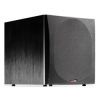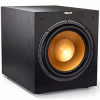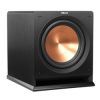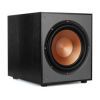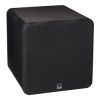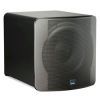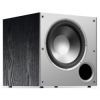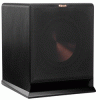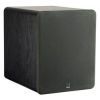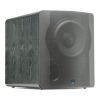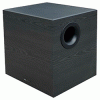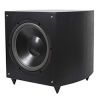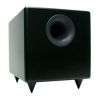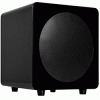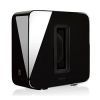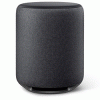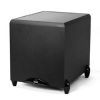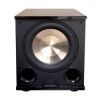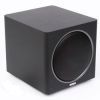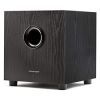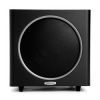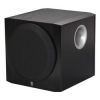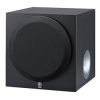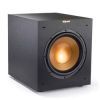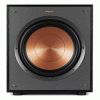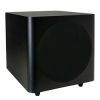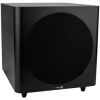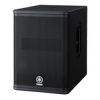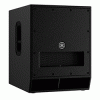| Overall | Audio features | Extensive connection | Control | |||
|---|---|---|---|---|---|---|
| SVS PB16-Ultra | 9.3 | 9 | 9 | 10 | See price | 41 |
| SVS PB-4000 | 9 | 10 | 8 | 7 | See price | 69 |
| SVS SB-4000 | 8.8 | 9 | 8 | 7 | See price | 68 |
| SVS SB-3000 | 8.6 | 8 | 8 | 10 | See price | 53 |
| JBL SRX828SP | 7.6 | 9 | 4 | 10 | See price | 12 |
| SVS SB-1000 | 7.6 | 7 | 8 | 8 | See price | 7 |
| Polk Audio PSW505 | 7.6 | 7 | 8 | 8 | See price | 2 |
| SVS SB-2000 | 7.3 | 7 | 7 | 8 | See price | 22 |
| BIC America F12 | 7.3 | 6 | 8 | 8 | See price | 4 |
| Dayton Audio SUB-1500 | 7.3 | 6 | 8 | 8 | See price | 37 |
The home subwoofer is a speaker that is responsible for low frequencies. The best subwoofer is not an independent acoustic unit, but an addition to stereo systems of type 2.1, 5.1 or 7.1. This is a universal solution for home use in rooms of various sizes.
There is a lot of speakers with a subwoofer, and they are somewhat more expensive than classic stereo speakers. This article will explain why a subwoofer is needed and how it improves a conventional stereo system. It will help to understand the types of subwoofers (here the best subwoofers are divided into several categories according to cost). All this will make it possible to understand whether a sub is needed or not worth overpaying. All the presented subwoofer reviews are about active models except one passive (last).
Home subwoofer reviews
Best subwoofers under $200
When you have a limited budget, you cannot be sure that you can find a quality subwoofer at an affordable price. Even if your budget is only $200, affordable subwoofers are available. You can enjoy the breathtaking sound at home without breaking your home theater budget if you choose one best subwoofer under 200 of these options. These are budget devices with a minimum set of characteristics but are quite capable of playing for all the money. Recommended for those who want to get a decent bass but do not spend a lot of money.
Polk Audio PSW10 - best budget

Polk PSW10 is a subwoofer from world-famous manufacturers of audio systems, which was warmly received by the positive feedback from the owners. Polk Audio PSW10 for a small price has sound quality on equal terms with more expensive models. That’s why it is named the best budget home theater subwoofer.
Polk Audio PWS10 has a strict minimalistic design. The case is cubic. A subwoofer is great for a 10-inch speaker. This case is more suitable for models with a 12-inch driver. The case is made of black oak with a silver facade. The manufacturer also provides a modification of varnished cherry. The subwoofer enclosure is designed so that a complex system of MDF barriers and thick walls prevents unwanted resonances and the formation of standing waves. Frequency and sound control are located at the rear. There is also a line-out and connectors for connecting external speakers with polarity. The Polk Audio PSW10 is a 10-inch subwoofer with a polymer composite diffuser and low-frequency reflection, which are located on the front wall of a thick MDF board. The driver and bass reflex are covered in a transparent acoustic mesh of black fabric. If you need it, it is easy to remove it, allowing access to the equipment. 
With the bass control located next to the toggle switch, you can adjust the sound in the range from 60 to 160 Hz. In addition, the best budget subwoofer has a built-in crossover so that you can select and correct the frequencies that you want.
Polk Audio PSW 10 transmits and displays low sound levels. The sound is crystal clear, and the timbre of each instrument and its parts are clearly defined. After the frequency was set to 2 \ 3 (it's about 106 Hz), I was amazed when I got a strong and clear sounding bass.
Key specs
- Power (RMS): 50 W
- Driver size: 10"
- Driver placement: front
- Frequency response: 35-200 Hz
- Official website
- Full specs
Pros
- Correct reproduction of bass after-tones
- Advanced connectivity eases the usage of this subwoofer
Cons
- The potential of a 30-centimeter driver at critically low frequencies is not fully disclosed
- Softened "fast" dynamics
BIC America F12 - best compact

A good model for home use from a well-known company in the USA. For more than 40 years of its existence, BIC America has become known as a company producing inexpensive and high-quality products and has also received numerous positive reviews from the leading consumer testing magazine.
BIC F12 is large and heavy but made in a minimalist style. The F12 is the best compact subwoofer, and that's why. The cubic style looks classic and attractive. The black case is made of thick black MDF laminate. Thick walls prevent unwanted resonances and the formation of standing waves. On the front panel is a 12-inch woofer. There are rubber pads for attaching the fabric mesh to the plastic pins on the front panel. The left and right sides are empty. Subwoofer controls are located on the rear panel. On the metal panel, there is the volume control, frequency control, stereo input jacks for the receiver and stereo output jacks for the speakers, an RCA jack, a three-position power button, and a power indicator. The port is managed by Bass Reflex. At the base of the case are four low cylindrical stands.
One of the features is a LED power detector. I tested a lot of subwoofers, and none of them had a power detector. In my case, this function was extremely convenient, because I was not always sure that the subwoofer was connected. 
The power switch is in the “AUTO” position and allows me not to worry about turning off the subwoofer. You just need to unscrew the volume control on the receiver to the “zero” position, and the whole system will turn off.
The subwoofer is equipped with a 12-inch subwoofer and amplifier with an operating power of 150 W and peak power of 475 W. I think that the power of the subwoofer is sufficient not only for home use but also for organizing a party in the backyard.
Key specs
- Power (RMS): 150 W
- Driver size: 12"
- Driver placement: front
- Frequency response: 25-200 Hz
- Official website
- Full specs
Pros
- It is made of polymer materials that allow it to withstand the peak power of the amplifier
- With phase switch, it is possible to synchronize the movement of diffusers speakers and a subwoofer for better sound quality
Cons
- It can get worryingly hot at high-usage twice. I was not able to use it for more than 4 hours heavily at a time
Best subwoofers under $300
If you’re looking for a way to boost your home theater or stereo system staying within the budget, you need the best subwoofer under 300. The modern subs of this price range feature many of the options the more expensive models offer, sounding steady and confident. They might be lacking the comfort of the wireless connection or adjustable sound wave direction; still, their bottom deepness and powerful bass won’t let anyone come back to a sub-less sound system.
Polk Audio PSW505

Polk PSW505 has a strict minimalistic design. The case is made in the form of an 18 mm MDF cube that looks like a black oak. The housing is mounted on metal supports. The front panel is painted in silver 25 mm MDF, and the black grille is easy to remove. The lattice frame is made of plastic and attached to the body with a plastic pin and rubber sleeve.
On the metal panel, there is a toggle switch with three positions (on, off, and auto), the main power switch, a phase toggle switch, and volume control. High-amplitude inputs and outputs (screw terminals) are shorted in pairs. There are 2 line inputs, an LFE input for a special signal from the AV receiver on the metal panel. The subwoofer weighs about 19 kg.
If we talk about the useful functions of the Polk Audio PSW505, then this subwoofer provides two automatic activation modes - “on signal” and rotation of the volume control. In addition, the subwoofer mute mode is always active when it is unavailable for 15 minutes.
The digital amplifier is designed for continuous power of 300 W and a peak power of 460 W with program material. The device is made of cellulose and polymer. These materials help it to remain as durable and flexible as possible in order to withstand the maximum load during operation. In general, this gives a reliable and durable construction where all the main channels of the amplifier are coated with glue to prevent air leakage.
The control scheme is logical, and the toggle switches and rotary knobs have quality and smooth operation. 
An important part of the subwoofer is a split-phase inverter. The wide and long phase amplifier significantly reduces noise and distortion, creating precise booming bass! It also provides an extension of the low-frequency range due to the resonance of this tube at a frequency lower than that reproduced by the speaker.
Polk Audio PSW505 has a broad amplitude of frequency from 23 Hz to 160 Hz. It is able to generate the low-end bass notes with incredible clarity what makes it the best home theater subwoofer in this price range.
Key specs
- Power (RMS): 250 W
- Driver size: 12"
- Driver placement: front
- Frequency response: 25-160 Hz
- Full specs
Pros
- It has a huge reserve of power, which will be enough even for a huge home cinema
- This subwoofer has all the necessary connectors and controls that make it easier to connect to any audio system
Cons
- In a week something inside the amps had burnt out or failed
Best subwoofers under $500
Those who value sound quality know that the best subwoofer under 500 allows you to make the sound stunning and much more enjoyable. If you're looking for something that won't hurt your budget, look for options that combine smart design at a reasonable price. Getting a good subwoofer for less than $500 is pretty easy. All you have to do is consider their advantages in terms of sound quality, build quality, connection method, and price.
SVS SB-1000 - best for music

Active (with built-in amplifier) model SB-1000 is the youngest device among the internal subwoofers of this brand. It is a world-class device, so it delivers incredible intensity, deep and clear bass. It is very compact and suitable even for a small room or studio. It belongs to class D and plays music files in a very wide frequency band. This is a home sub, but the device is perfect to be used in cafes, skating rinks, and other public places because this is the best subwoofer for music.
The cabinet is a regular-shaped cube with a premium black ash finish. Side size is 12.99 inches. It is stiff enough and has rounded edges that impede internal resonance. Although the interior is small, the subwoofer has a large 12-inch head that covers almost the entire front panel. The device is stylish and neat, as it is made of medium-density fiberboard. This woody material makes the subwoofer affordable and improves its acoustic performance.
The main characteristics of SB-1000 are of high quality. A full set of inputs - stereo, high and low, LFI - expands the ability to connect a subwoofer with various amplifiers. For example, two terminals with a low input can be connected to an amplifier. 
It is equipped with a powerful digital amplifier with a maximum power of 720 watts. 300 W power allows you to install both in small and large rooms. The sub has a DSP (processor) that acts as a limiter.
The case is not too rough and can vibrate, but only if you make an abnormal volume. It has its own volume control, which makes the device independent of the receiver volume settings. Two ferrite magnets, magnetic systems, a voice coil, and a rubber universal joint with a wide range of motion from above minimize distortion in the emitter.
Key specs
- Power (RMS): 300 W
- Driver size: 12"
- Driver placement: front
- Frequency response: 24-360 Hz
- Official website
- Full specs
Pros
- The injection time is regulated very smoothly
- It looks discreet, but modern, and assembled, by the way, very high quality
Cons
- If you approach the issue of quality very meticulously, you could probably get a little more musicality or a little more power
- Some users will not appreciate the bright LED
Klipsch R-12SWi - best wireless

The best wireless subwoofer Klipsch R-12SWi is made to be used both in stereo systems and in home theaters and is able to sound effective in large rooms. The design of the device is made in a single concept with the Klipsch Reference Series speakers, which successfully combine black and copper-gold colors.
Klipsch R-12SWi is equipped with a 12-inch woofer, which is located on the front panel and is covered with a removable protective net. The bass has a cast graphite diffuser (IMG) with an external copper coating that dampens unwanted vibrations and resonances. The speaker is connected to a powerful amplifier operating in class D. The subwoofer body is made of thick MDF, equipped with internal ties and damping to eliminate coloring the sound at high volume, and its outer part is made of rough vinyl film. On the front of the subwoofer is a power-on indicator.
On the back of the Klipsch R-12SWi is a traditional set of controls. For the input filter, volume and frequency controls are provided, as well as an absolute signal phase switch. Klipsch R-12SWi is equipped with linear and LFE inputs. However, the feature of this model is that it provides the ability to wirelessly connect to a signal source. 
For this, the Klipsch R-12SWi has a built-in receiver, and a transmitter paired with it is included with the device. The latter can be connected to the LFE or line output of an AV receiver or stereo amplifier. The signal is transmitted at a frequency of 2.4 GHz without compression, which provides a wide dynamic range of sound and an accurate transmission frequency.
Key specs
- Power (RMS): 200 W
- Driver size: 12"
- Driver placement: front
- Frequency response: 29-120 Hz
- Official website
- Full specs
Pros
- The ability to connect wirelessly greatly simplifies the placement of the Klipsch R-12SWi in a room
- The subwoofer develops significant sound pressure and without distortion performs the most dynamic special effects of modern films
Cons
- It doesn't have a low enough extension as for me personally
- The roll-off slope also appears to be a rather high
Best subwoofers under $1000
The competent choice of the best subwoofer under 1000 depends not only on the quality of the speaker or the power of the amplifier. Subwoofer with a softer and more natural sound has a closed-back volume, which allows you to enjoy not only the blues but also many very extreme styles of instrumental music. The tape-type case, in which the diffuser works with the internal volume on both sides (all the sound comes out through the hole in the box), provides maximum efficiency, but this type of subwoofer can be recommended only for certain users with certain tastes.
SVS SB-3000

Firstly, this is a completely new 13-inch (non-standard size, right?) speaker with an aluminum diffuser, two ferrite magnets, and a voice coil with two windings wound with a wire with a flat cross-section. Naturally, a special long-stroke suspension and the “long-stroke” dynamics are clearly emphasized by a curved metal grill. The grill itself causes conflicting feelings in terms of aesthetics, but it can be removed. Moreover, there is no more bright blue LED on the front panel - nothing will distract from viewing.
The proprietary speaker is a proprietary 800-W Sledge Class D amplifier, capable of delivering 2.5 kW at a peak. All this is enclosed in a rather compact case from MDF, and control over the entire system is carried out by the DSP-processor Analog Devices with a frequency of 50 MHz. The device is controlled from the rear panel, where all the controls and simple indicators in the form of LEDs are located. However, it is most convenient to configure the device through the application, as described below. 
Switching SB-3000 is quite simple - an exceptionally low-level connection in both mono and stereo versions. There are low-level outputs if you want to connect several subwoofers in a row. Also on the rear panel is a USB connector for connecting a wireless receiver, which is supplied separately. The bass is fast enough, not booming (although this is partly due to the processed room), large-scale. It is big and cool, but when compared with subwoofers of a different level, it is not so structured and elegant (however, other manufacturers want more money).
Key specs
- Power (RMS): 800 W
- Driver size: 13"
- Driver placement: front
- Frequency response: 18-270 Hz
- Official website
- Full specs
Pros
- SB-3000 bass is assembled, with a natural attack and without extraneous overtones
- All actions are displayed on the smartphone screen and at the same time changes in sound are heard
Cons
- I didn’t like screw-in rubber feet
Sonos SUB

The original shape of the Sonos SUB enclosure is due to its design - the device uses two counter-directional speakers working on a common central cavity. Due to this, the developers managed to solve several problems at once and, first of all, to make the sub-insensitive to the installation location in the room. The Sonos SUB subwoofer can even be installed along walls or furniture without sacrificing bass quality. In addition, the speakers mutually cancel out the vibrations of the cabinet walls that they create, which makes the Sonos SUB sound unpainted even at high volume. The subwoofer can be placed vertically or horizontally, which is very convenient.
Each speaker is connected to its own Class D amplifier, which ensures high bass power without significant heating of the device itself. To control the sound of Sonos SUB, a DSP is used with software settings made through a special application. The device has an Ethernet connector for connecting to the Sonos system, and when using the optional Sonos Bridge, the entire kit can also work from a home router. The subwoofer housing has deep internal damping, and all the connectors are mounted on the bottom panel in such a way as to make the connection as inconspicuous as possible. 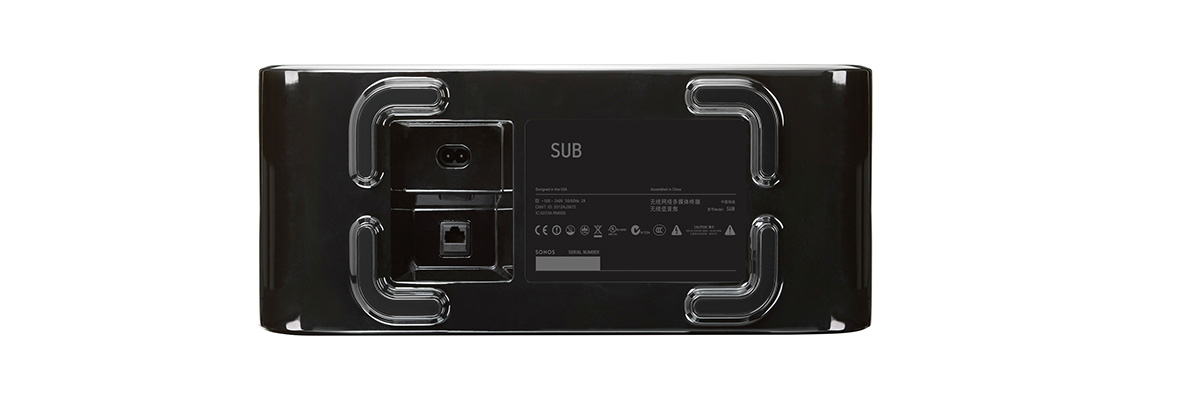
There are dual speaker ports. The frequency range is up to 25 Hz. The Sonos SUB has all filter settings, active equalizer, and time adjustment are made digitally through DSP (digital signal processing) for sound without loss of sound quality.
Connect the subwoofer to the Sonos system by pressing a single button on the device. The device is optimally matched to work with PLAYBAR, CONNECT speakers: AMP, PLAY 5, 3, 1. Automatic sound equalization system. All components of the system will be optimally tuned. This subwoofer can be used to create both stereo and multi-channel audio systems. Thanks to the high-quality exterior with black piano lacquer and the modern design, Sonos SUB fits perfectly into the residential interior.
Key specs
- Power (RMS): N/A
- Driver size: 6"
- Driver placement: front
- Frequency response: 25-200 Hz
- Official website
- Full specs
Pros
- Speakers sound better than the multi-room
- The Bright LED can be configured to turn on/off via the Sonos app
Cons
- The app is clunky and looks outdated
Best High End subwoofers
A good subwoofer should have a very linear driver (which is expensive), an accurate and powerful amplifier (which is expensive too), and also a well-designed and built chassis. But cutting corners on any of the listed aspects is a false saving. So let’s consider buying the best subwoofer for home theater.
SVS PB16-Ultra - best performance

The SVS PB16-Ultra is the perfect subwoofer for people who want to shake an entire building with sharp bass. This model is built and engineered using the latest technology that helped achieve clear audio output. The PB16-Ultra is not only a very powerful solution but also looks very modern. Below you will see why this model is the best powered subwoofer in terms of performance.
The body is made of MDF and makes the whole structure strong and durable. The front partition is made of double-thickness MDF, and the optimized design of the cabinet mount makes it stable and completely free of resonances. Smooth edges and a nice finish make this model very modern. This model is equipped with a display with several buttons, which makes it easy to configure various parameters. The display is integrated into the front chamfer so that you can easily get to the buttons and use the display. The rear panel has all the necessary ports. This model has RCA LFE inputs and outputs, XLR inputs, and outputs.
The rated output power is 1500 watts, and the maximum output power is 5000 watts. The output power of the audio amplifier is 4000 watts. This high power output makes it ideal for use in large areas. The frequency response is from 16 Hz to 460 Hz, and the crossover frequency is from 30 Hz to 200 Hz. Therefore, this model not only handles a wide range of frequencies perfectly, but you can also mix it with other speakers you have. In addition, this model is equipped with advanced digital signal processing technology, which simplifies the process of the audio overlay. 
This model comes with an application compatible with Android and Apple devices. The application allows you to control polarity, phase alignment, parametric equalizer, room gain, and other DSP functions. You can also save, and load presets. The reliable Bluetooth module installed in this model allows you to access this subwoofer even at a great distance.
Key specs
- Power (RMS): 1500 W
- Driver size: 16"
- Driver placement: front
- Frequency response: 14-360 Hz
- Official website
- Full specs
Pros
- The SVS app for controlling the sub is easy to navigate and has a great interface
- The 15 amp circuit breaker is plenty to handle this unit. Even while also using other gadgets on the same dedicated circuit
Cons
- You have to research what each setting is dedicated to
Best passive subwoofers
JBL PRX418S

JBL has developed its passive subwoofer of the PRX400 series with high computing power and an extended frequency response needed for nightclubs, DJs, churches, concerts, and other applications. These speakers are equipped with JBL-approved road components in rugged, road-worthy enclosures so you can count on reliable night-to-night performance.
The JBL PRX418S is a compact, high-power subwoofer with a JBL Selenium 457 mm (18 ″) woofer in a ventilated enclosure. The subwoofer provides a flexible input connection system for compatibility with virtually any cable. The input panel has a pair of Neutrik Speakon NL-2/1/4 ″ TS Phone Combo Jack. The body is made of birch/poplar and coated with a durable DuraFlex coating. The steel grill has an internal lining with an acoustically transparent screen for additional speaker protection and a professional look.
The PRX418S subwoofer is in a compact portable hardwood casing providing continuous power up to 800 W (or peak power 3200 W). When properly amplified, this subwoofer will give your dimension a whole new dimension, and the audience hears and feels low notes. 
JBL built a sturdy case made from a 0.7-inch birch laminate/poplar with a 16 gauge steel grill and JBL DuraFlex trim. The 36 mm pole mounting socket allows the JRX218S to serve as the basis for a medium and high speaker housing, such as the JBL PRX415. The JRX218S offers the performance and durability that JBL is renowned for in its tough, compact packaging, a convenient way to go deep.
Key specs
- Power (RMS): 800 W
- Driver size: 16"
- Driver placement: front
- Frequency response: 52-120 Hz
- Official website
- Full specs
Pros
- This speaker is well received for being loud and punchy, as expected with its 18" woofer design
- There are many who describe it as having a clear bass sound that's great for kick drums, bass guitar and more - even when at high volume levels
Cons
- Bulk and weight seem to be a minor gripe
Buying guide
Passive vs powered subwoofers
There are two types of subwoofers: passive and powered. The difference between them is very simple. Passive subwoofers require an external amplifier to operate, while active subwoofers have an internal amplifier, and they just need to be connected to the network.
The advantage of powered is that it greatly simplifies the process of connecting your subwoofer to your system: all you have to do is lay an RCA cable between them (most receivers have a dedicated output for the subwoofer) and a power cable from the subwoofer to the outlet.
Front-firing vs down-firing subwoofers
Subwoofers are further divided into two categories: front-firing or down-firing. This is easy to understand. If the driver (a large round element, similar in functionality to the floor speakers) is located on the front panel of the device, then this is front-firing. When bottom - down-firing. The situation is complicated a little further, some subwoofers, in fact, fire in several directions - front and rear. Models like this one are pretty unusual. You may reasonably think of what the differences between the two are. In fact, there are not many of them - not enough, given the differences between rooms and different circumstances, to achieve significant changes. Low frequencies are omnidirectional, which means that it’s not so important which one you choose.
Ported vs sealed subwoofers
Sealed subwoofers have a fully enclosed case with no holes inside. Ported subwoofers have one or more openings for free air movement. Simply put: sealed subwoofers sacrifice a low overall volume and presence for a denser, more controlled sound, while ported subwoofers can pump out tremendous volume due to low clarity. Generally speaking, larger and more expensive subwoofers are usually portable, while smaller and cheaper ones are not.
If you have a smaller room and you do not need to knock out windows, then perhaps you should take a look at the sealed subwoofer. If you are still not going to download music in huge volumes, then it makes sense to put a little more clarity and depth into the sound, and not increase the volume.
Driver size explained
In the case of subwoofers, size really matters. To produce bass sounds, you must be able to produce a lot of energy. The larger the loudspeaker, the more energy you can spend (although most of this is due to the gain received by the driver). In general, you should purchase a subwoofer with a driver larger than 12 "- it's 12" across from end to end. Anything less will give a good sound but do not expect huge low power.
Wattage explained
Generally speaking, the more watts, the louder the subwoofer will work, although it is a bit more complicated. Think of power as the range in which you press the subwoofer. The higher the range, the louder you can do it without distorting the sound. Watts can be low (60 watts) or excessively high (4000 watts), and as you can imagine, you pay more for a higher power. Note the difference between the RMS (sometimes called continuous) and peak (sometimes called dynamic) power. Always look at RMS and ignore the peak. The first relates to total capacity in an established and usually reasonable amount. The latter refers to the absolute volume that a thing can go to. You will need the first. Do not believe the advertising. Everything related to an RMS power of around 1000 watts should be more than suitable for most people, although you can go much higher if you want.
Wireless vs wired subwoofers
There is a slight dichotomy here. Most home theater or Hi-Fi subwoofers have a wired connection, while many have sound panels and are completely wireless. The advantage of wireless subwoofers is that they do not require tuning. They will already be subordinate to the central device, and all you need to do, in most cases, is to connect them. The intersection point is already set, so they eliminate the difficulties in the initial setup, although you will. Of course, you need to decide where to put them, and they must be plugged into an outlet.
The disadvantage is that in almost all cases, they do not sound as good as wired subwoofers.
Subwoofer crossover explained
This is the most important thing you can do to improve the sound of your subwoofer. As you probably already understood, the subwoofer is designed to work at low frequencies. But despite the fact that your speaker system is well designed, this is not reasonable. It does not know where these low frequencies begin. There is a huge range in which they occur, and unless you say it differently, your speaker system can redirect some low-frequency information in your sound to your surround speakers or front speakers - information that will be much better processed by your subwoofer. Adjusting this point — the frequency below which all sound is sent to your subwoofer — is called setting the crossover point.
Typically, a crossover is set using the on-screen setup of your A / V receiver. This should allow you to select a specific frequency without any problems.
Using more than one subwoofer
If you think the bass is good with one unit, would it be better with two? Or four? The answer, of course, is yes, but you also risk distorting or simply suppressing other sounds in the mix. If you want to try this, and you have money to scatter, then the unit in every corner of the room (although not opposite the walls, please) will amaze you.
But this, of course, is not necessary, and if you make the right choice, you will have what you love. Honestly, we will take it upon ourselves, spending a huge amount of money on several variations of the same thing, just to produce endless bass. If you really really want to annoy your neighbors. Or you live in the desert.
FAQ
Where do you put a subwoofer
When placing a subwoofer in a room, there are certain nuances that you need to know:
- The worst place to install a subwoofer is in the center of the room
- The worst form of a room is a square
If you place the subwoofer in the center of the room, then the amplitude-frequency characteristic of the low-frequency speaker system will be the worst. It is characterized by non-linearity, a large number of "humps" and "troughs," which negatively affects the sound quality. When you move the bass speaker from the center of the room to the wall, the bass level, and its intelligibility will increase. The maximum return of the low-frequency speaker system will be when it is installed in the corner of the room. At the same time, the place for listening to sound should not be near the wall. The sofa or chair should be moved at least 60-70 cm.
You can install the subwoofer against the wall arbitrarily, but it is better if there are no objects between it and the listener, and the speaker is turned towards the listener. To determine where it is better to put a subwoofer in the room, you can act on the contrary. Do not move the heavy speaker system from place to place, but put it on a chair or sofa, that is, at the listening point, and yourself, moving around the room, find the most suitable place in terms of low-frequency sound. Then put a subwoofer in this place.
How to connect a subwoofer to an AV receiver or amplifier
- A special line output of the amplifier or receiver is connected to the line input of the built-in amplifier of the subwoofer type RCA (tulip). This input may be stereo. Inside the subwoofer, the signals from these inputs are usually mixed, or go to 2 different amplifiers. Some subwoofers have a dual coil speaker, a coil with two windings. A separate amplifier is connected to each winding. If your receiver has one RCA connector for connecting a subwoofer, then the receiver (amplifier) is connected by the double end of the Y-cable (1 RCA to 2 RCA) to the two-line inputs of the subwoofer (its inputs are parallelized).
- A stereo power amplifier or a receiver is used without a special linear output to the subwoofer. Then the connection is through the terminals on the subwoofer - its inputs (bypassing the built-in amplifier). The left and right terminals of the amplifier are connected by an acoustic cable to the terminals of the subwoofer - its inputs, parallel to the front speakers.
Powered subwoofers (with built-in amplifier) are connected by RCA - RCA coaxial cable, in other words (tulip-tulip). One end of the wire into the subwoofer, the second one to the 6-channel analog panel on the receiver into the connector labeled Subwoofer. If the RCA connectors on the subwoofer are 2 (L and R - In) or 4 (L and R - In and Out), then use the white connector.
To connect a subwoofer, you can use the output terminals, which are used to connect speakers. In this case, the subwoofer and speakers will operate in the low-frequency range in parallel.
The subwoofer is sometimes connected to the output terminals located on the amplifier. Then the speakers are connected to the high-level output terminals located on the subwoofer. The fact is that in front of these terminals are high-frequency filters of 6 dB, which reduce the pressure in the low-frequency range exerted on the speaker systems. In this case, the operation of the devices is not carried out in parallel; in other words, this connection method allows you to increase the workload exerted on the entire system.
-
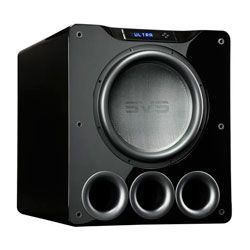 #1
#1SVS PB16-Ultra
- SVS
- | 2500
- 33
-
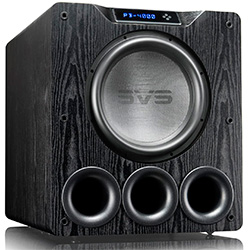 #2
#2SVS PB-4000
- SVS
- | 1900
- 18
-
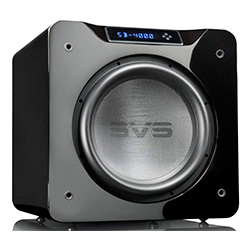 #3
#3SVS SB-4000
- SVS
- | 1600
- 34
-
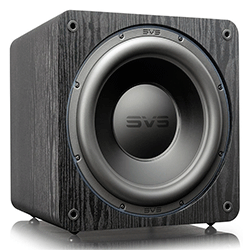 #4
#4SVS SB-3000
- SVS
- | 1000
- 80
-
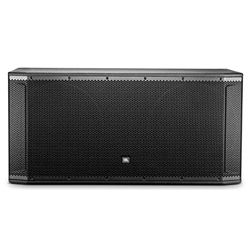 #5
#5JBL SRX828SP
- JBL
- | 1900
- 23
-
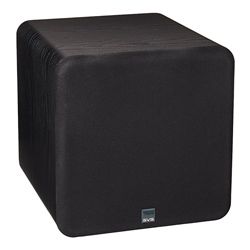 #6
#6SVS SB-1000
- SVS
- | 500
- 189
-
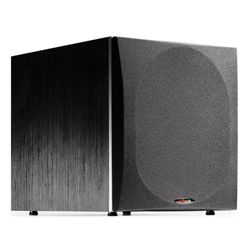 #7
#7Polk Audio PSW505
- Polk Audio
- | 300
- 2983
-
 #8
#8SVS SB-2000
- SVS
- | 700
- 208
-
 #9
#9BIC America F12
- BIC America
- | 300
- 1980
-
 #10
#10Dayton Audio SUB-1500
- Dayton Audio
- | 300
- 99
-
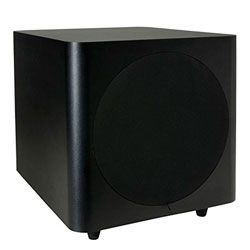 #11
#11Dayton Audio SUB-800
- Dayton Audio
- | 200
- 106
-
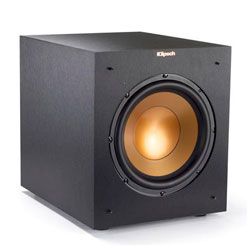 #12
#12Klipsch Reference R-10SWi
- Klipsch Reference
- | 300
- 281
-
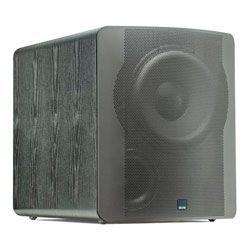 #13
#13SVS PB-2000
- SVS
- | 600
- 161
-
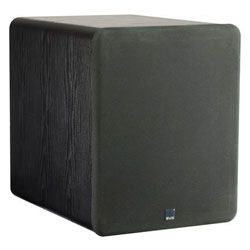 #14
#14SVS PB-1000
- SVS
- | 500
- 241
-
 #15
#15Dayton Audio SUB-1200
- Dayton Audio
- | 200
- 184
-
 #16
#16Dayton Audio SUB-1000L
- Dayton Audio
- | 200
- 40
-
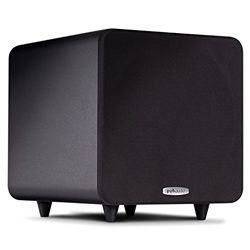 #17
#17Polk Audio PSW111
- Polk Audio
- | 300
- 463
-
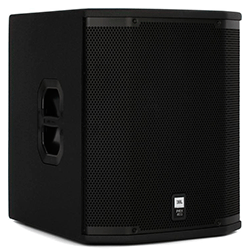 #18
#18JBL PRX418S
- JBL
- | 800
- 30
-
 #19
#19Audioengine S8
- Audioengine
- | 400
- 267
-
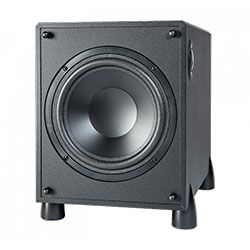 #20
#20Definitive Technology ProSub 1000
- Definitive Technology
- | 500
- 95
Recent reviews
